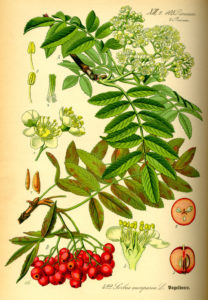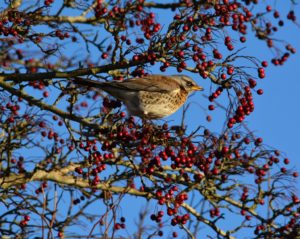Of wicked trees and autumnal stuff

Pink-footed Geese © Harry Bickerstaff
Traditionally Autumn is the time of the year when Montrose Basin experiences an influx of Pink-footed Geese.
It is also the moment of the year when the trees turn red, yellow, orange and brown, when days get shorter and nights darker, and for the smaller birds that inhabit the Basin, their feeding pattern changes because the view gets full of their favourite berries.
These little red berries come from Rowan trees, and right in this period you can admire them in all their splendour from the Visitor Centre’s viewing area… along with the birds occupied to enjoy them.
The Rowan is a very important tree in European folklore: it is associated to white magic and is the runes’ tree, since it was on its wood that the Druids traced their formulas in the ancient language.
From the berries of this lavish shrub it produces jams, chutney and wine. In Wales they were used to produce beer and cider, and the bark was used to dye dark the wool that kept .warm in winter. Rowan was also planted nearby cemeteries to ensure a peaceful rest to the dead.
It is said moreover that they keep away the witches, but in view of our Halloween Event on the 29th of October, we hope not!
Rowan is a small-medium sized, deciduous tree, it tolerates harsh climates and conditions, so much that in Scotland we can find them growing on cliffs, steep stream-sides and on top of large boulders.
It is also known as Mountain Ash because it is capable of growing at altitudes till 760m (2500ft), and because of the similarity between its leaves and the Common Ash tree’s leaves.
The Latin name is Sorbus aucuparia, and in my country – Italy – is known as “Sorbo degli uccellatori” (literally translated: bird catchers’ Rowan), just because people used to hunt in the vicinity of it to catch the birds attracted in big number by Rowan’s berries, an important source of sugar and nutrients that birds “store” for the winter.

A Goldcrest (is lovely, isn’t it?) © Andy Wakelin
In these weeks I’ve seen for myself the changes of our Rowan tree, situated right in front of one of our windows. A great observation point, indeed.
If until ten days ago it was full of the famous berries, now you could find just three of them!
Blackbirds, Blue tits, and Chaffinches are common visitors that shake the branches, and in the last few days we had the pleasure to spot a couple of Song Thrushes. Warblers of different species wander around (and trying to find out which species is always a challenge), and a pair of lovely Goldcrests have appeared. I spotted a Redwing, some Blackcaps, and we hope to soon see Mistle Thrushes, Fieldfares and Waxwings.
All of this reminds us that winter is coming (brrr) and while some birds that inhabit the Basin – and our gardens – are going to leave Scotland towards warmer countries, most of them will stay here and keep us company. So it’s appropriate to think about support feeding them.
Essentials to know when feeding birds;
- Situate feeder in places away from predators – like cats or dogs;
- Not too much food at the same time but refill regularly;
- Avoid feeding bread, it is better to choose seed mixtures as they are generally fit for most of the birds;
- For insectivores – Robins, Tits, Blackcaps and Blackbirds – we can offer small pieces of apple, raisin, hazelnuts and walnuts, and biscuits’ sweet crumbs as well.
Listening to the songs of these little creatures for me is always a joy, they make me feel at home, and I wish to continue to spot new and exciting species. Perhaps on the Rowan, our wicked tree that always has a surprise in store.
Marika Davoli – EVS volunteer



